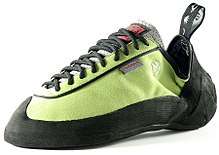Climbing shoe
A climbing shoe is a specialized type of footwear designed for rock climbing. Typical climbing shoes have a close fit, little if any padding, and a smooth, sticky rubber sole with an extended rubber rand. Unsuited to walking and hiking, climbing shoes are typically donned at the base of a climb.[1]
| Part of a series on |
| Climbing |
|---|
 |
| Background |
| Types |
| Lists |
| Terms |
| Gear |
Construction
Modern climbing shoes use carefully crafted multi-piece patterns to conform very closely to the wearer's feet. Leather is the most common upper material, with other materials such as fabric and synthetic leather also employed.[2] The climbing rubber used for soles was developed specifically for rock-climbing.
Climbing shoes manufactured with a downward pointing toe box increase the ability to stand on small holds and pockets at the expense of both comfort and the ability to smear.
Approach shoes are hybrids between light-weight hiking shoes and climbing shoes offering some of the qualities of each.
Shoe fit
Climbing shoes fit very closely to support the foot and allow the climber to use small footholds effectively. Most climbers forgo socks in order to achieve a more precise fit. As a result of their tightness, most climbing shoes, particularly the more aggressive or technical styles, are uncomfortable when properly fitted.
History
Early rock climbers used heavy-soled mountaineering boots studded with metal cleats and hobnails. An advance on this for dry rock, were boots with Vibram soles, with a pattern of rubber studs developed by Vitale Bramani in Italy in the 1930s.[3] In postwar Britain, a new generation of climbers like Joe Brown began to climb harder routes wearing plimsolls (rubber-soled canvas sneakers),[4] sometimes with woolen socks over them to improve grip.[5] Pierre Allain was an enthusiastic French rock climber who experimented with hard composite rubber-soled canvas boots; by the late 1950s his "PA" boots were being used by climbers worldwide. Fellow French climber Edmond Bourdonneau later introduced "EB" boots in 1950 after purchasing Pierre's company,[6] which had softer rubber soles and became very popular in the 1960 and 1970s. In 1982 Boreal, the Spanish company located in Villena, produced the "Firé" style of shoe with a revolutionary sticky rubber sole.[3]

Climbing shoe manufacturers
References
- Cox, Steven M. and Kris Fulsaas, ed. (September 2003). Mountaineering: The Freedom of the Hills (7 ed.). Seattle: The Mountaineers. ISBN 0-89886-828-9.
- "How to Choose Climbing Shoes". Athlete Audit. Archived from the original on 2017-08-19.
- Mitchell, Peter (13 January 2011). "The History of Climbing Shoes". Livestrong.com. Archived from the original on 5 November 2012. Retrieved 6 April 2013.
- Kincaid, Simon. "Joe Brown: The Gritstone Legacy". Climber. Archived from the original on 4 August 2012. Retrieved 6 April 2013.
- http://www.joe-brown.com/putting-joes-achievements-into-context.html Archived July 27, 2011, at the Wayback Machine
- "EB Historical EB". EB Climbing Shoes. Archived from the original on 7 September 2017. Retrieved 29 March 2018.
External links
![]()